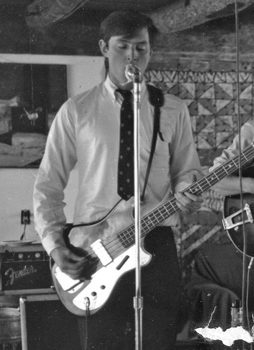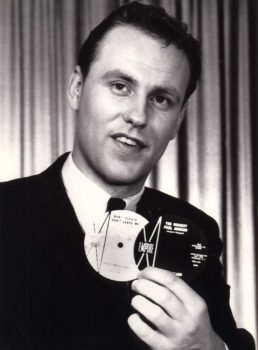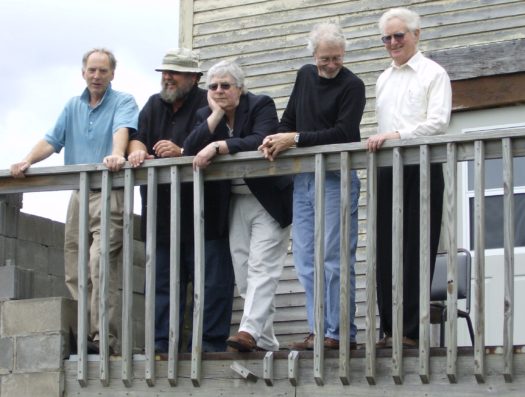

The only surviving photo of early Mike and the Ravens. L-R: Peter Young, Mike Brassard,
Steve Blodgett, Northfield town chairman Earl Rinker, Bo Blodgett, Eddie Jones
Late one Saturday night in 1962, the window of the Community Church in Stowe, Vermont creaked open. Three teenagers clamored through, dragging a box behind them. They climbed up to the church steeple, which contained the building’s sound system. Every day at noon it blanketed the town with a recording of tolling bells (despite a bell tower, the church did not have any real bells).
The teenagers opened their box and slipped a different recording out of its sleeve, a vinyl set of covers of the latest frat-rock hits: “Get a Job” by The Silhouettes, “The Stroll” by the Diamonds, and a handful more. They removed the tolling-bells record, put in their rock album, and pressed play.
They say the rock and roll woke up people as far as six miles away. The boys scurried home in the darkness as Bill Justis’s twangy “Raunchy” filled the streets.
Stowe being a small town, this prank did not prove to be the unsolved crime of the century. When the ringleader’s mother heard about it the next morning, she immediately pegged her son as the culprit. He was promptly arrested and forced to go back to school, breaking up his band.
 That ringleader was 17-year old Steve Blodgett, and the band he left behind was Mike and the Ravens. Until their sudden breakup, Mike and the Ravens were the hottest thing going in Vermont and upstate New York in the early 1960s. With Blodgett writing most of the songs for charismatic frontman Mike Brassard to sing, they packed roller rinks and frat parties on both sides of the state line. Roaring through an arsenal of original songs and covers, they became one of the wildest – and most popular – bands on the scene. Producer Will Shade has termed them the “R&B Ramones,” but their punky energy not only predated the Ramones, but even predated the ’60s garage-rock bands that could have been their peers, like the Dave Clark Five or Kingsmen.
That ringleader was 17-year old Steve Blodgett, and the band he left behind was Mike and the Ravens. Until their sudden breakup, Mike and the Ravens were the hottest thing going in Vermont and upstate New York in the early 1960s. With Blodgett writing most of the songs for charismatic frontman Mike Brassard to sing, they packed roller rinks and frat parties on both sides of the state line. Roaring through an arsenal of original songs and covers, they became one of the wildest – and most popular – bands on the scene. Producer Will Shade has termed them the “R&B Ramones,” but their punky energy not only predated the Ramones, but even predated the ’60s garage-rock bands that could have been their peers, like the Dave Clark Five or Kingsmen.
In the early 1960s, the Beatles hadn’t made it out of Hamburg yet, and Elvis was off in the army. Artists like Roy Orbison, Del Shannon, and Chubby Checker were keeping rock and roll alive in America and, locally, Mike and the Ravens were doing the same. They became the biggest band in the Vermont/upstate New York scene, driving around for a constant stream of gigs at frat parties, school dances, meeting halls, and roller rinks.
Though the band members hailed from Vermont, nearby Plattsburgh, NY soon became their professional base. The local rock and roll scene there was small but passionate. For one, both of the two area record labels were based in Plattsburgh. For another, the drinking age in New York state was still 18, as opposed to Vermont’s 21. And perhaps most importantly, there was a local air force base containing 7,000 young men looking for some fun in a sleepy town. One of their air force fans known as Wild Bill Kennedy even became a local rocker himself, recording Blodgett’s tribute to the Ravens’ favorite club Rollerland after Blodgett got shipped off to college.
Mike and the Ravens began when high schools friends Brian Lyford and Peter Young met local songwriter Steve Blodgett while caddying across the state line in New York. Soon Mike Brassard joined the trio. They formed a band with the rather unfortunate name Mike and the Throbs and quickly learned four cover songs for their first gig. “We played loud and fast and I came away with the notion that girls liked it,” Brassard says.
Unusually, though, the Ravens didn’t stick with covers. Most dance bands made a living knocking out the popular hits of the day, but from the beginning the mercifully rechristened Mike and the Ravens performed original tunes. Six of their songs got recorded before the church prank-induced breakup, and each one is fantastic. Their stated influences included the Everly Brothers, Link Wray, and Bo Diddley, but in many ways they sound more like bands that came shortly after: Dave Clark Five, Paul Revere and the Raiders, and, yes, the Beatles.
Counterintuitively, on first first two of the three singles they released, the B-side is better than the A-side. The reason, Blodgett recalls, was probably that the Top 10 contained a lot of mid-tempo “pretty” songs in 1961 and 1962 – the rock and roll revolution came in fits and starts – and so songs in that vein got priority. Their record company likely pushed him to make his softer songs the singles.
For instance, their first single, 1962’s “Mr. Heartbreak” is an agreeable pastiche – Roy Orbison on the verses, Everly harmonies in the chorus – but B-side “I’ve Taken All I Can” is the true knockout. Blodgett still calls it his favorite song they did, and you can see why. Rocking and instantly catchy, it blends garage-rock propulsion with John-and-Paul harmonies. Though he was only 17 at the time, Blodgett emerged fully-formed as a rock songwriter.
This dichotomy is even more apparent on their second single. The band now disowns the A-side “Baby, Please Don’t Leave Me” (“I prefer to try and forget [that song]…” is Brassard’s comment on the subject). The offending element is a female duet partner their manager forced them to add to the track. They’re right that the back and forth is truly corny, like a non-seasonal “Baby, It’s Cold Outside,” but it’s agreeable in a Malt Shop Memories sort of way. They’d prefer you listened to a recently unearthed female-free alternate take though.
Undeniable though is that the B-side “The Biggest Fool Around” is far stronger – it’s my favorite song of theirs. Once again, it’s much more upbeat than the A-side, and catchier too (also: no female singer). Bo Blodgett delivers twangy guitar leads that underpin his brother Steve’s earwormy melody. The band incorporates doo-wop with everything great about the first wave of rock and roll. This is the band at their absolute best and, in another world, could have been a real honest-to-goodness hit.
Their third and final single was the only time they got the track order right. A-side “Goodbye to Mary Jane” is a knockout, a gritty rave-up that presaged bands like the Kingsmen and much of the influential Nuggets garage-rock compilation. It incorporates a little surf guitar and points the way towards a psychedelic sound still a few years away. And this time they put the schmaltzier track, “Living in a Dream” on the B-side.
But by that last single, they were already a dead band walking. Its recording was Blodgett’s curtain call after his prank led to the band’s demise. After releasing only three 45s, the band was abruptly over after only a year.
 Brassard still remembers where he was when he heard what his bandmates had done in the church steeple. “I was driving back from New York City and we had the radio on,” he says. “At noon there was this story about how someone had broken into the Stowe Vermont community church and played a rock and roll record on the church carillon system. They said the music woke people up for miles around. I knew instantly it could only have been the Ravens that would pull such a brilliant stunt. It wasn’t long, though, before fear crept in after they were arrested. It was then I realized we would lose Steve and that all their parents would use the incident to break up the Ravens and get the boys back in school.”
Brassard still remembers where he was when he heard what his bandmates had done in the church steeple. “I was driving back from New York City and we had the radio on,” he says. “At noon there was this story about how someone had broken into the Stowe Vermont community church and played a rock and roll record on the church carillon system. They said the music woke people up for miles around. I knew instantly it could only have been the Ravens that would pull such a brilliant stunt. It wasn’t long, though, before fear crept in after they were arrested. It was then I realized we would lose Steve and that all their parents would use the incident to break up the Ravens and get the boys back in school.”
The members regrouped in various ways for the next few years without their main songwriter. A new lineup of Mike and the Ravens kept gigging around Burlington, even making a fan of a young Jon Voight, who up in Vermont for summer stock theater (“I didn’t realize who he was to become until I saw Midnight Cowboy a couple years later,” Brassard says). A band made up of the Ravens rhythm section called the Thunderbolts grew their own fanbase and even appeared on the Ed Sullivan Show, albeit backing another singer and barely getting any screen time themselves. Blodgett eventually finished school and reunited with Brassard in a Turtles-style folk-rock band called Fire and Brimstone in the late 1960s.
But by then, Mike and the Ravens’ chance at broader success had passed. By the time the Beatles took their sound worldwide, Blodgett was off in college and the band was no more.
“It’s hard to know if we would have made it as a band if we hadn’t broken up,” Blodgett says. “A little more than a year after the band split up the Beatles started getting airplay in the US. If we hadn’t had a hit by then, would we have been left behind? Would we have self-detonated? But truly I think we would have found the song and the studio to crack the top 100. That was our goal, and every one of us was pretty determined to get what we wanted in life.”
In recent years, the band has reformed, inspired by that producer Will Shade, and released two new albums that continue the Ravens tradition fifty years later. They’ve made up some of the lost time and even recorded some of Blodgett’s old songs that never saw release the first time around. Like so many other young men who once played in rock bands, they have all lived full lives in various careers and music is now only a hobby. But every now and then, they still wonder what might have been.
“I had many feelings about leaving the band as result of the steeple prank,” Blodgett remembers today. “One was relief to have been caught at something because I was starting to do other ‘pranks’ that could have gotten me into more trouble. A second feeling was of real loss. These guys were my best friends and we had worked to become a good band. Two months after I left the band I drove to see them playing without me at the University of Vermont. On the way I heard Brenda Lee’s ‘All Alone Am I’ on the car radio and teared up. When I heard them play that night, I was stunned at how tight they were. I went home and wrote a song: ‘I Left my Life Behind’.”

The reunited Mike and the Ravens in 2009
To get copies of the early Mike and the Ravens songs, pick up the compilation ‘Heart So Cold: Plattsburgh-Burlington 60s Scene’. And to hear what the reformed Ravens are up to today, check out their recent three albums ‘Noisy Boys’, ‘From Pillar to Post’ and ‘No Place for Pretty.’
Special thanks to those albums’ producer Will Shade for all his help with research.
Click here to read more articles about Vermont music history.
One Response to “Unearthing the Legacy of Mike and the Ravens, the Northeast’s Greatest Lost ’60s Rock Band”
Sorry, the comment form is closed at this time.

I came back from Germany in the Air Force back in 61. Had a successful band over there and was anxious to get something started in my home city of Columbus Ohio. The music scene was dreadful. Yes there were a few hard core rockers but few and far between. Economy was bad and so I re-upped and was sent to Plattsburgh AFB in upstate NY. A god awful place in the winter but with a active and exciting music scene. One of the biggest show case places was a roller rink called Rollerland. They would run local bands three- four times a week and bring in national recording acts a couple times a month. One Sunday afternoon they were broadcasting live on a local radio station and this band called Mike and the Ravens were playing. It sounded like a train wreck. Blasting guitar, an out of control singer, real exciting stuff. So I vowed that the next time they were booked in I’d go see them. Couple weeks later I got my wish and made my way to Rollerland. What I saw and heard was unbelievable. The guitar player in a white dress shirt, a skinny tie hanging around his neck and bathed in sweat pounding on a sunburst Strat. The lead singer in the same condition jumping all over the stage like a mad man. What was remarkable was that the music was balls to the wall rock and roll. Crash, boom, bang. Just like it’s supposed to be played. I had found rock and roll heaven. I went on to join a band called the Twiliters. We were managed by the same guy who managed the Ravens. We even recorded one of their unreleased songs called Rollerland.
They should have made it. They had all the things needed to be a national act. God only knows why they didn’t. They were truly a great band. One of the best…